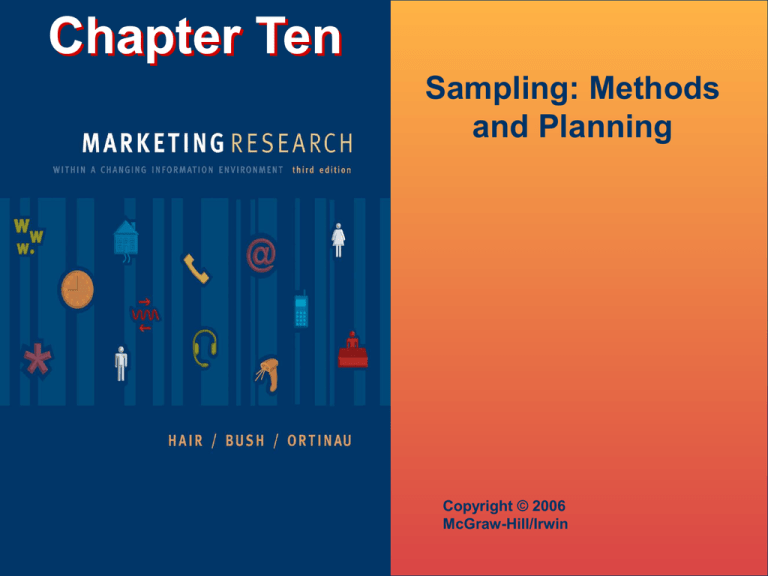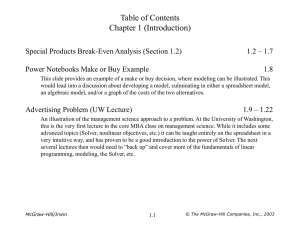
Chapter Ten
Sampling: Methods
and Planning
Copyright © 2006
McGraw-Hill/Irwin
Learning Objectives
1. Distinguish between probability and
nonprobability sampling methods.
2. Understand the advantages and
disadvantages of probability sampling and
nonprobability sampling designs.
3. Illustrate the factors necessary for determining
the appropriate sample design.
4. Understand the steps in developing a
sampling plan.
McGraw-Hill/Irwin
2
Exhibit 10.1
McGraw-Hill/Irwin
Distinguish between probability and
nonprobability sampling methods
3
Exhibit 10.2
McGraw-Hill/Irwin
Distinguish between probability and
nonprobability sampling methods
4
Types of Probability
Sampling Designs
Distinguish between probability and
nonprobability sampling methods
• Simple Random Sampling
Probability of Selection = Size of sample/Size of Population
PoS=n/N
• Example: Sample of 1500 from a population of 10,000 =15%
chance of being selected
– Advantages
• Easy
• Unbiased estimates of population’s characteristics
– Disadvantages
• Difficult to obtain complete listing of the target population
elements
McGraw-Hill/Irwin
5
Types of Probability
Sampling Designs
Distinguish between probability and
nonprobability sampling methods
• Systematic Random Sampling (SYMRS)
– Skip interval = defined target population list size/ desired
sample size
– Skip interval = Defined N/Desired n
– A sample of 1000 from a target population of 15,000 the skip
interval would be 15
• Advantages
• Easy and economical
• Unbiased estimates of population’s characteristics
• Disadvantages
• Difficult to obtain complete listing of the target population elements
• Must know exactly how many sampling units make up the defined target
population Target population must be ordered in some random way
• Sample may have hidden patterns not found by the researcher
• IE Stores sales sampled every 7 days falling on a Saturday
McGraw-Hill/Irwin
6
Exhibit 10.4
McGraw-Hill/Irwin
Distinguish between probability and
nonprobability sampling methods
7
Types of Probability
Sampling Designs
Distinguish between probability and
nonprobability sampling methods
• Stratified Random Sampling (STRS)
– Goal
– Three basic steps for drawing a STRS
– Two common methods used
• Proportionate stratified method
– Sample size from each stratum dependant on stratum’s relative
size to the defined target population
• Disproportionate stratified method
– Sample size from each stratum is independent on stratum’s
relative size to the defined target population
– Optimal allocation
• Consideration is given to relative size of stratum
as well as variability within the particular stratum
McGraw-Hill/Irwin
8
Exhibit 10.5
McGraw-Hill/Irwin
Distinguish between probability and
nonprobability sampling methods
9
Types of Probability
Sampling Designs
Understand the advantages and
disadvantages of probability
sampling designs
• Advantages
– Assurance of Representativeness
– Opportunity to study each stratum
– Ability to make estimates for target population
• Disadvantages
– Difficult in determining the basis for stratifying
McGraw-Hill/Irwin
10
Types of Probability
Sampling Designs
Distinguish between probability and
nonprobability sampling methods
• Cluster Sampling
– Each cluster is representative of the heterogeneity of the
target population
– Area sampling
• One-step approach
• Two-step approach
Advantages
– Cost effectiveness
– Ease of implementation
– Often only reliable method available
Disadvantages
• Tendency for clusters to be homogeneous in nature
• Appropriateness of the factors used to sample within clusters
McGraw-Hill/Irwin
11
Exhibit 10.6
McGraw-Hill/Irwin
Distinguish between probability and
nonprobability sampling methods
12
Types of
Nonprobability
Sampling Designs
Distinguish between probability and
nonprobability sampling methods
• Convenience Samples
– Drawn based at the convenience of the researcher
• Assumption samples represent population
– Not likely
• Advantages
– Large number of respondents
– Used in early stage of research
• Disadvantages
– Problems of reliability
– Do respondents represent the target population
– Results are not generalizable
McGraw-Hill/Irwin
13
Types of
Nonprobability
Sampling Designs
Distinguish between probability and
nonprobability sampling methods
• Judgment sampling
– Selected based on an experienced
individual’s belief
• Advantages
– Based on the experienced person’s
judgment
• Disadvantages
– Cannot measure the respresentativeness
of the sample
McGraw-Hill/Irwin
14
Types of
Nonprobability
Sampling Designs
Distinguish between probability and
nonprobability sampling methods
• Quota sampling
– Based on prespecified quotas regarding
demographics, attitudes, behaviors, etc
• Advantages
– Contains specific subgroups in the proportions
desired
– May reduce bias
• Disadvantages
– Dependent on subjective decisions
– Not possible to generalize
McGraw-Hill/Irwin
15
Types of
Nonprobability
Sampling Designs
Distinguish between probability and
nonprobability sampling methods
• Snowball Sampling
– Respondents identify additional people to
included in the study
• The defined target market is small and unique
• Compiling a list of sampling units is very difficult
• Advantages
– Identifying small, hard-to reach uniquely defined
target population
– Useful in qualitative research
• Disadvantages
– Bias can be present
– Limited generalizability
McGraw-Hill/Irwin
16
Exhibit 10.7 Critical Factors in
Selecting the Appropriate
Sampling Design
McGraw-Hill/Irwin
Illustrate the factors necessary for
determining the appropriate sample
design
17
Exhibit 10.8 Steps
Involved in Developing
a Sampling Plan
McGraw-Hill/Irwin
Understand the steps in
developing a sampling plan
18
Summary
• Value of Sampling Methods in Marketing
Research
• Types of Probability Sampling Designs
• Types of Nonprobability Sampling
Designs
• Determining the Appropriate Sampling
Design
• Steps in Developing a Sampling Plan
McGraw-Hill/Irwin
19
Chapter
Eleven
Overview of
Measurement:
Construct
Development and
Scale
Measurement
Copyright © 2006
McGraw-Hill/Irwin
Learning Objectives
1. Explain what constructs are, how they are
developed, and why they are important to
measurement and scale designs.
2. Discuss the integrated validity and reliability
concerns underlying construct development and
scale measurement.
3. Explain what scale measurement is, and describe
how to correctly apply it in collecting raw data from
respondents.
McGraw-Hill/Irwin
21
Learning Objectives
4. Identify and explain the four basic levels of scales
and discuss the amount of information they can
provide a researcher or decision maker.
5. Discuss the hybrid ordinally-interval scale design
and the types of information it can provide
researchers.
6. Discuss three components of scale development
and explain why they are critical to gathering
primary data.
McGraw-Hill/Irwin
22
Overview of the
Measurement Process
Explain what constructs are, how
they are developed, and why they
are important to measurement ad
scale designs
• Measurement
– Process of determining the amount of
information about persons, events, ideas,
and/or objects of interest and their
relationship to business problems or
opportunities
McGraw-Hill/Irwin
23
Overview of the
Measurement Process
Explain what constructs are, how
they are developed, and why they
are important to measurement ad
scale designs
• Researchers assign numbers or label to
– People’s thoughts, feelings, behaviors and
characteristics
– Features or attributes of objects
– Aspect of ideas
– Any types of phenomenon or event using
specific rules to represent quantities
and/or qualities of a factor
McGraw-Hill/Irwin
24
Overview of the
Measurement Process
Explain what constructs are, how
they are developed, and why they
are important to measurement ad
scale designs
• Construct Development
– Goal is to precisely identifying and
defining what’s to be measured
– Buyers attitudes on price or quality
• Scale Measurement
– Goal is to determine how precisely
measure each construct
– Scale: sometimes, always, never vs. 1-2 times 3-4
times 5 or more times
McGraw-Hill/Irwin
25
Overview of the
Measurement Process
Explain what constructs are, how
they are developed, and why they
are important to measurement ad
scale designs
• Object
– Any tangible item in a person’s environment that can be
clearly and easily identified through his or her senses
– Car, cheesecake, student
• Elements
– Researches want to measure elements that make up the
objects:
– Objective properties:
» a car’s colour, horsepower
» a student’s income, weight, sex
– Subjective properties are abstract and intangible like:
» a car’s style, a student’s opinion of an instructor, purchase
intentions
• Construct
– Hypothetical variable made up of a set of component
responses or behaviors that are thought to be related
McGraw-Hill/Irwin
26
Overview of the
Measurement Process
Explain what constructs are, how
they are developed, and why they
are important to measurement ad
scale designs
•
Construct development
– an integrative process in which researchers determine what
specific data should be collected for solving the defined research
problem
– Need to determine what exactly needs to be measured to solve the
problem.
•
Accurate identification of what should be investigated requires
–
Knowledge and understanding of constructs
–
Knowledge of dimensionality
–
Knowledge of validity
–
Knowledge of operationalization
McGraw-Hill/Irwin
27
Overview of the
Measurement Process
Explain what constructs are, how
they are developed, and why they
are important to measurement ad
scale designs
Heart of Construct Development - Determine
exactly what is to be measured
1. Objects that are relevant are identified first
2. The objective and subjective properties of each object
are specified
3. Concreteness of an object–limited to measuring the
object’s objective properties
4. Object’s subjective properties–must identify
measurable subcomponents that can be used to clarify
the abstractness associated with the object’s subjective
properties
Rule of thumb is that if an object’s features can be directly
measured using physical instruments, then that feature
is not a construct
McGraw-Hill/Irwin
28
Overview of the
Measurement Process
•
Explain what constructs are, how
they are developed, and why they
are important to measurement ad
scale designs
Determining What Is to Be Measured
– the need to acquire relevant, high-quality data to
support management’s decisions
– Example Dealer Service Quality=Abstract construct
1. Domain of observables –portfolio of identifiable and
measurable components associated with an abstract
construct
2. This preliminary information gathered from secondary
research and exploratory research such as focus groups is
then used as a guideline for collecting data from a more
representative sample about attributes
Domain of observables- What do customers think is important
when evaluating dealer service quality? Waiting room,
employee attitudes, repairs done on time, clean car when
returned.
McGraw-Hill/Irwin
29
Overview of the
Measurement Process
Discuss the integrated validity and
reliability concerns underlying
construct development and scale
measurement
Assessing the Validity of the Construct
–
an after-the-fact activity–after creating the scale, collecting the
data, then the researcher performs the statistical analyses
1. Content validity or “face” validity
How well the construct measurable components represent that
construct
2.
Convergent validity
How well the construct measurement positively correlates with
different measurements of the same construct
3.
Discriminant validity
Whether the construct being investigated differs significantly form
other constructs that are different
4.
Nomological validity
How well one a theoretical construct compares to a established one
McGraw-Hill/Irwin
30
Overview of the
Measurement Process
Discuss the integrated validity and
reliability concerns underlying
construct development and scale
measurement
• Approaches Used to Collect Data for Assessing
Construct Validity
– Pilot study
• Using 50 people who represent the defined target population
• Using a panel of experts—independently judge the
dimensionality of the construct
• Inappropriate Scale Measurement Formats
– Ways to overcome After-the-fact data
• Direct cognitive structural analysis
– Ask respondents to tell you what attribute is important and
how important that attribute is to the construct being
examined
• Scale reliability
McGraw-Hill/Irwin
31
Overview of the
Measurement Process
Discuss the integrated validity and
reliability concerns underlying
construct development and scale
measurement
• Inappropriate set of respondents
– Using college students to represent the population as a whole
– Using college students in construct development–drawn using a
convenience sampling approach
• Construct Operationalization
– Operationalization
• explaining a construct’s meaning in measurement terms by
specifying the activities or operations necessary to measure it.
– The process focuses on the design and use of questions and
scale measurements to gather the needed data
McGraw-Hill/Irwin
32
Exhibit 11.2
McGraw-Hill/Irwin
Discuss the integrated validity and
reliability concerns underlying
construct development and scale
measurement
33
Basic Concepts of Scale
Measurement
Explain what scale measurement
is, and describe how to correctly
apply it in collecting raw data from
respondents
• Types of Data Collected in Research Practices
– State-of-Being Data
• Factual characteristics that can be collected or verified in other
ways. Sex, age, income
– State-of-Mind Data
• Mental attributes or emotional feelings that are not directly
observable or available from other sources
– Feelings, beliefs
– State-of-Behavior Data
• Current observable actions or past actions
– Can collect data by asking the individual, observing them or
researching sales data Air Miles does this
– State-of-Intention Data
• Asking targets what their intentions are
– Difficult to verify intentions with actual behaviour
McGraw-Hill/Irwin
34
Basic Concepts of Scale
Measurement
Explain what scale measurement
is, and describe how to correctly
apply it in collecting raw data from
respondents
• Scale Measurement
– process of assigning descriptors to represent the range of
possible responses to a question about a particular object or
construct
• The quantity and quality of the responses associated with any
question or observation technique depend directly on the scale
measurements used by the researcher
• The focus is on measuring the existence of various characteristics
of person’s response
• Scale measurement directly determines the amount of raw data that
can be ascertained from a given questioning or observation method
• Scale Points
– designated degrees of intensity assigned to the responses in a
given questioning or observation method
McGraw-Hill/Irwin
35
Exhibit 11.3
McGraw-Hill/Irwin
Explain what scale measurement
is, and describe how to correctly
apply it in collecting raw data from
respondents
36
Basic Concepts of Scale
Measurement
•
Explain what scale measurement
is, and describe how to correctly
apply it in collecting raw data from
respondents
Properties of Scale Measurements
– Assignment Property
• Description or category
» Favorite colour? Do you own a car
– Order Property
• 3 relationships between responses A and B
– A > B or A < B, A = B
– Identifies relative differences not absolute
» Not satisfied with service, satisfied with, very satisfied
– Distance Property
• Expresses the absolute difference between each of the descriptors or scale
points
• Restricted to responses with some type of natural numerical answer
» How much do you spend at Loblaws per month
» $0-10,11-20, 21-30, 31-40 etc.
– Origin Property
• Refers to the use of a unique starting point in a set of scale points that is
designated as being a “true natural zero”
• Each scaling property builds on the pervious one
McGraw-Hill/Irwin
37
Exhibit 11.4
McGraw-Hill/Irwin
Identify and explain the four basic
levels of scales and the amount of
information they can provide
38
Basic Types of
Scales
Identify and explain the four basic
levels of scales and the amount of
information they can provide
• Nominal Scales
– type of scale in which the questions require
respondents to provide only some type of
descriptor as the raw response
– Does not contain level of intensity
• Yes or no, male or female, shop or not shop at
• Ordinal Scales
– allows a respondent to express relative
magnitude between the answers to a question
• Never, Few times, often, always
McGraw-Hill/Irwin
39
Exhibit 11.5
McGraw-Hill/Irwin
Identify and explain the four basic
levels of scales and the amount of
information they can provide
40
Exhibit 11.6
McGraw-Hill/Irwin
41
Basic Types of
Scales
Identify and explain the four basic
levels of scales and the amount of
information they can provide
• True Class Interval Scales
– Not only an assignment and order but also a distance
property
– demonstrate the absolute differences between each
scale point
• Shopped 2 times versus 5 times at Safeway per month
• Spend $20 dollars vs. $100 per visit.
• Hybrid Ordinally-Interval Scale
– an ordinal scale that is artificially transformed into an
interval scale by the researcher
• Primary scale point descriptors
• Secondary scale descriptors
McGraw-Hill/Irwin
42
Exhibit 11.7
McGraw-Hill/Irwin
43
Basic Types of
Scales
Identify and explain the four basic
levels of scales and the amount of
information they can provide
• Ratio Scales–
– the researcher can identify the absolute differences,
not only between each scale point but also to make
comparisons between the raw responses
• Enable a “true natural zero” or “true state of nothing”
response to be a valid raw response to the question
• Ratio scales requests that respondents provide a specific
numerical value as their response, regardless of whether or
not a set of scale points is used
» How many cars do you own?
» How much do you spend on maintenance?
McGraw-Hill/Irwin
44
Exhibit 11.9
McGraw-Hill/Irwin
Identify and explain the four basic
levels of scales and the amount of
information they can provide
45
Development and
Refinement of Scaling
Measurements
Discuss three components of scale
development and explain why they
are critical to gathering primary
data
• Key to Designing High-quality Scales
– Understanding the defined problem
– Establishing detailed data requirements
– Identifying and developing the constructs
– A complete measurement scale consists of
three critical components
• The question
• The attribute
• The scale point description
• Development of the constructs
McGraw-Hill/Irwin
46
Exhibit 11.10
McGraw-Hill/Irwin
Discuss three components of scale
development and explain why they
are critical to gathering primary
data
47
Exhibit 11.11
Key Criteria in Scale
Development
McGraw-Hill/Irwin
Discuss three components of scale
development and explain why they
are critical to gathering primary
data
48
Development and
Refinement of Scaling
Measurements
Discuss three components of scale
development and explain why they
are critical to gathering primary
data
• Criteria for Scale Development
– Intelligibility of the Questions
• Degree respondents understand question
• Instructions can be used to improve
– Appropriateness of Primary Scale Descriptors
• The extent to which the scale point elements match the
data being sought
– Discriminatory Power of the Scale Descriptors
• The scales ability to significantly differentiate between the
categorical scale responses
• Generally scales have 3-7 points
McGraw-Hill/Irwin
49
Development and
Refinement of Scaling
Measurements
Discuss three components of scale
development and explain why they
are critical to gathering primary
data
– Reliability of the Scale
• Scale reliability
– Test-retest
» Repeating the scale measurement with either the same
sample at different times or two different samples from
the same target population.
» If there are few differences the scale is viewed as stable
and reliable
– Equivalent Form
» Measure and correlating the measures of two equivalent
scaling instruments
– Internal consistency
» Split-half tests
» Coefficient alpha
McGraw-Hill/Irwin
50
Development and
Refinement of Scaling
Measurements
Discuss three components of scale
development and explain why they
are critical to gathering primary
data
– Balancing positive/negative scale
descriptors
• Having equal relative magnitudes of positive and
negative scale measures
– Inclusion of a neutral response choice
• Forced-choice scale
– No neutral descriptive forces respondent to make
choice
• Free-choice scale
– Includes a neutral descriptive
McGraw-Hill/Irwin
51
Discuss three components of scale
development and explain why they
are critical to gathering primary
data
McGraw-Hill/Irwin
52
Development and
Refinement of Scaling
Measurements
•
Discuss three components of scale
development and explain why they
are critical to gathering primary
data
Measures of Central Tendency
– Mean
• The average of all data
– Median
• Split of data half below half above
– Mode
• Most frequently given response
•
Measures of Dispersions
– Frequency Distribution
• Summary of how many times each possible response was recorded
– Ranges
• Represents the grouping of responses in mutually exclusive subgroups,
each with an upper and lower boundary
– Sample standard deviations
• Statistical value that specifies the degree of variation in the data
responses
McGraw-Hill/Irwin
53
Exhibit 11.13
McGraw-Hill/Irwin
Discuss three components of scale
development and explain why they
are critical to gathering primary
data
54
Summary
• Value of Measurement within Information
Research
• Overview of the Measurement Process
• Basic Concepts of Scale Measurement
• Basic Levels of Scales
• Development and Refinement of Scaling
Measurements
McGraw-Hill/Irwin
55









